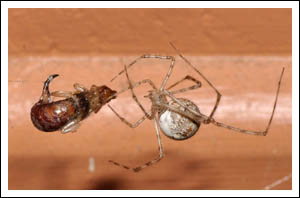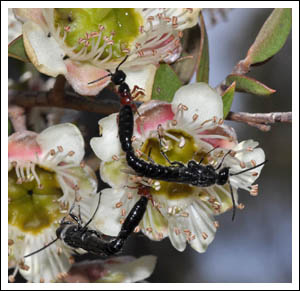An unwelcome component of the garden ecosystem can be the European earwig, often found under loose bark and in cracks and crevices in large numbers. This one came to a sticky end in the web of a Theridiid house spider.
Jumping spiders in search of prey roam the walls of the house and break-wind fences, this Ocrisiona species favours the latter.
Following the hot day mentioned in the previous post, thunderstorms with rain showers swept through. Next morning the garden was refreshed and insect life was abundant. The Leptospermum macrocarpum was a magnet for mating wasps, with the males taking the wingless females to the flowers for them to feed on nectar prior to laying their eggs.
The Callistemon sieberi on the other hand attracted numbers of the spectacular blue/black flower wasp, Scolia soror. Unfortunately due to the need to use flash to freeze their movement, the blue sheen on the wings was nearly impossible to capture. They are obviously efficient pollinators.
This Ichneumon wasp, Lissopimpla excelsa however was interested in the Persoonia cornifolia.
Click to enlarge.





















